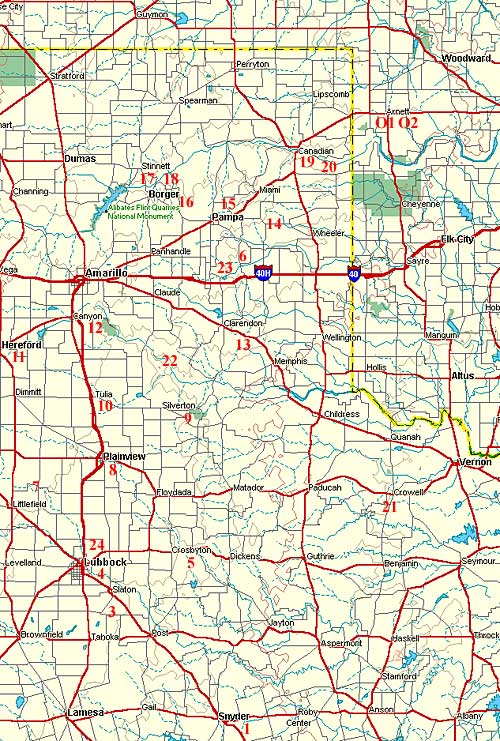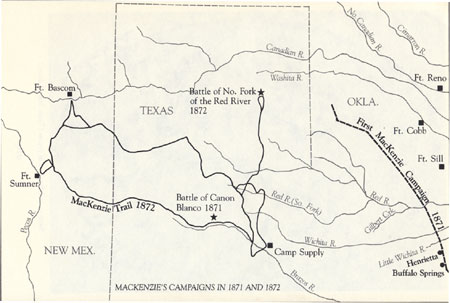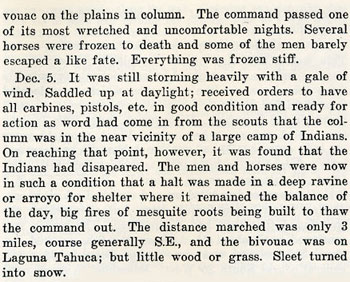Panhandle/Staked Plains |
Topics (Click on a topic to jump to that section)
16-Adobe Walls, Battle of | 18-Adobe Walls, Battle of | 17-Adobe Walls, First Battle of | O2-Antelope Hills | 20-Buffalo Wallow Battle Ground | 19-Lyman's Wagon Train Battle, Site of | 3- Mackenzie Cavalry Camp, Site of | 9-Mackenzie Reservoir and Tule Canyon, Archeological Site at | 4-Mackenzie Scout Trail | 2-Mackenzie Trail | 11-Mackenzie Trail | 8-Mackenzie Trail, Old | 1-Mackenzie Trail, Site of the | 7-Mackenzie Trails, One of the | 5-Main Supply Camp on Historical Mackenzie Trail | 23-McClellan Creek | 13-Mobeetie Trail, Old | 14-Mobeetie/Mobeetie Jail Museum | 6-North Fork of Red River, Battle of | 10-Palo Duro Canyon | 12-Palo Duro Canyon, Battle of | 22-Palo Duro Canyon #1 | 21-Pease River Battlefield | 15-Rescue of Two White Girls by Lt. Frank Baldwin | O1-Washita, Battle of the | 24-Yellow House Canyon | 18-1/2-Zulu Stockade, Site of Old
Borger Home Page
Canadian Home Page
Canyon Chamber of Commerce
Clarendon Chamber of Commerce/Tourism
Crowell City Page
Lubbock Convention and Visitor's Bureau
Mobeetie Texas Association
Pampa Area Chamber of Commerce
Panhandle Nation (All cities in the Panhandle)
Plainview Chamber of Commerce
Plainview City Page
Silverton Page
Snyder Chamber of Commerce
Spearman Chamber of Commerce
Historical Markers by County
Museums
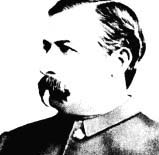
Ranald S. Mackenzie
Sherman invested a large effort in the protection of his former enemies since the end of the Civil War. He assigned his best cavalry officer, Ranald S. Mackenzie, to command the Texas frontier. The Indians called him "Bad Hand" due to his loss of several fingers in a Civil War battle. His hand was just the most visible of dozens of wounds he'd received and though young, he was as grouchy as the most cantankerous old man. The colonel effectively saw to the construction and manning of Forts Concho, Griffin and Richardson but the soldiers thought of him mainly in the capacity of dispensing discipline.
Mackenzie's raiders, as the grateful citizens soon referred to the Fourth Cavalry , began to strike deep into the Plains in the early 1870s. Here the troops found conditions harsher than their commander's temper. Their objective was to strike Comanche winter camps where the warriors were practically immobile due to the lack of grass for their ponies. Ironically victory was achieved because the ornery colonel successfully utilized stubborn army mules to resupply his men and horses on the battlefield.
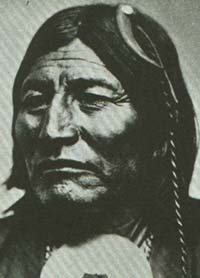
Mow-way (Shaking Hand)
Photo from the book, Carbine & Lance, The Story of Old Fort Sill, by Colonel W. S. Nye; Copyright © 1937 by the University of Oklahoma Press. Reprinted by permission. All rights reserved.
The Fourth had their first important victory when they attacked Mow-way's Comanche band on the North Fork of the Red. Previously at Blanco Canyon, near Lubbock, Mackenzie's nemesis, Quanah Parker, led a night raid on the army's horse herd.
Mackenzie Destroys Comanche Village on North Fork of Red River, 1872
The new commander of the Department of Texas, Gen. C.C. Aguar, sent a detachment from Fort Concho under Capt. Napoleon Bonaparte McLaughlin on a two-month reconnaissance patrol. He returned to confirm captured comanchero Ortiz's assertions that the main force of the Comanches were in camps located in the Staked Plains and that army columns could successfully maneuver in that country. Aguar then summoned Mackenzie to San Antonio where they held a strategy meeting where they developed a campaign against the Comanche in their stronghold in the Staked Plains.
McLaughlin's recounter revealed a band of Comanche containing over two hundred lodges, with a herd of well over one thousand horses, was camped somewhere on the Staked Plains. Ortiz speculated that it would probably be found in either Cannon Blanco Mucha Que Valley, North Fork of the Red River or Palo Duro Canyon.
Mackenzie reestablished Camp Supply on Duck Creek, where he concentrated his command and dispatched several scouting parties, one of which discovered a well used road with hoof prints of a large herd of cattle stretching west toward the Staked Plains. This news peaked Mackenzie's interest and on July 28th he marched two hundred forty troopers west. August 7th, the men resupplied and rested at Ft. Sumner, New Mexico and then marched north to Ft. Bascom, New Mexico, arriving August 16th.
Ortiz, who accompanied Mackenzie, directed the return route east, skirting Palo Duro Canyon. Mackenzie split off detachments to search possible locations of the Indian camp but with no success. They returned to Camp Supply on August 31st. The expedition had marched over 640 miles over the last month and had traversed the Staked Plains by two new routes, These routes were both shorter and better watered than the Goodnight-Loving trail that was currently being used to drive cattle to markets in New Mexico.
Mackenzie rested his men until September 21st when he marched his command north to search the last potential lair of the Comanche, the North Fork of the Red River. On September 28th, a scouting patrol, under Boehm, discovered a large Kotsoteka Comanche village. The command moved within a half mile of the village before they were spied by the Indians. From there they charged the village, overtaking it after a half-hour battle. Mackenzie lost three men and had three wounded. The Comanche lost an estimated fifty or more including Chief Kai-Wotche and his wife. Mow-way (Shaking Hand) escaped.
Mackenzie had to promise his Tonkawa scouts their pick of the Comanche horses, which were estimated to be a herd of 3,000, for them to desist mutilating and scalping the Comanche victims. Mackenzie also took one hundred thirty women and children prisoner and had all their property gathered up and burned. He made camp two miles from the smoking village. It took the Comanche two attempts that night to stampede their herd. The soldiers were able to recapture only fifty horses. Mackenzie returned to Ft. Richardson on October 23. Nine Congressional Medals of Honor were awarded for gallantry during this campaign.
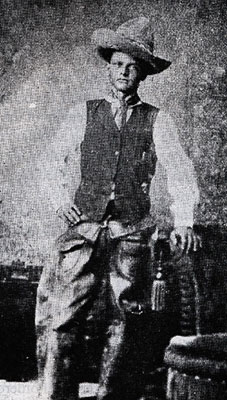
Captive Clinton L. Smith
The following story is a first-hand account of white captive Clinton L. Smith:
One morning I got up to build the fire. It was just at good daylight. The camp as about two miles long and no one else in that whole village seemed astir. Suddenly I heard the roar of guns, and looking down toward the end of the village, I saw smoke rising., I called to my chief to get up quick, for something was happening in camp. He grabbed his gun and rushed out, followed by the squaws. He yelled to me that it was an attack by white men, and for us all to run. One squaw had a little baby. She picked it up and started for the creek. My old gray mule was staked nearby by the foot. The chief jumped on the mule, took his son up behind him, and then put out his foot and told me to climb on too, which I did in a great big hurry, and away we went. But in our haste we had forgotten to cut the stake rope, and down came the mule, throwing all three of us in a pile. The chief sprang to his feet, cut the rope and we all got on again and rode for dear life.
General McKenzie had slipped up on us during the night, with his troops, and waited until daylight to try and capture the whole camp. By the time we were mounted and ready to ride the fight was on in earnest, and at close quarters. That old gray mule was scared badly, and when the chief gave a yell and turned him loose he almost quit the earth. General McKenzie was leading the attack on one side of us, and a captain of rangers was leading the attack on the other side, while a whole string of soldiers were following us and literally pumping lead into our badly demoralized camp. We had to run about four hundred yards to escape from the fight, but about five hundred succeeded in getting away. They killed our horses so fast in front a good many fell over them. As we were running Cachoco's horse was shot down in front of us. He squatted down among the bushes and as General McKenzie passed by he put an arrow through his jacket, barely missing the skin. General McKenzie told me of this incident afterward, when I had a long talk with him at Fort Concho. Cachoco never ran. He shot all of his arrows away, but he left several dead men to show for his brave stand. Taken so unexpectedly the Indians had no equal chance, and many were killed. It seems that the soldiers tried to make a massacre of this attack, for they killed squaws, babies, warriors and old white headed men. The band of us who escaped went up the creek and circled around a little ridge and watched them fight. The chief sent runners to other Indian camps to ask for help, and by night our force had increased to fully one thousand warriors, and while we were getting ready to make a bold stand, the fight stopped, about 3 o'clock p.m. The troops captured all of our loose horses, several thousand, and moved down the creek about ten miles, and we returned to the scene of battle and picked up all of the wounded. This little creek was of running water with deep holes from fifty to seventy-five yards long. Long grass grew along the edges of the stream and hung over the water. Many of the Indians escaped by jumping into the water and hiding under the overhanging grass. So many were killed and wounded in the water that is was red from hole to hole with blood. The camp was wholly destroyed, and there were many dead soldiers and horses lying about.
The soldiers had captured many of the Indians and took them along with them, herding them like cattle. Among the captured was our second chief, a long, slim, red-looking Indian. He wore the black star painted on his breast indicating bravery. The captives were all afoot, and this Indian broke out of the herd and ran for a long distance before he was overtaken. His pursuers succeeded in roping him back to the herd, more dead than alive. General McKenzie also told me about this, as did the chief when he got away and came back to the tribe.
We fixed up to follow the soldiers and try to rescue our people s well as retake our horses. After what I had seen that day I was mad all over, and was willing to risk anything to get even with the soldiers.We had good horses and good arms, and although our chief told us he did not think we could whip the enemy, we were determined to have another battle and try to stampede the horses. We started on their trail, leaving the squaws behind to care for the wounded. I will never forget my horse; he was a big, long, slab-sided red roan, and a splendid traveler. We rode fast until we located the camp of the soldiers, when we halted and watched them until dark. They had a number of wagons which had been formed in a circle, in the center of which had been placed the captured Indians, and these were being guarded by a large force of soldiers, while other soldiers were herding the horses. We awaited until darkness had enveloped the earth, and then, guided only by starlight, we approached to within a hundred and fifty yards of the camp, to await the chief's signal for attack. When the signal was given it found us all ready to make the charge. With loud yells we dashed forward shooting at the guards, who promptly returned the fire. The Indians in the camp were quick to take advantage of the confusion, and many of them made their escape, but with fixed bayonets the guards held most of them in check. Some of the Indians crawled out between the wagon spokes, and some even crawled through the soldiers' legs in getting away. When I had fought for some time I discovered my gun was empty, so Old Roan and I left there. I could not hold my horse. The harder I pulled the faster he ran. The soldiers turned the captured horses loose to save their camp, and these were in a stampede, all seemed to be running for dear life. Soon I found myself right in the middle of the running horses. I managed to work my way to the outside of the herd and found that part of the Indians had followed up to recapture the horses. We went some distance and made camp about daylight, and all through the day Indians were straggling in from the scene of the night before. About two hundred succeeded in making their escape. General McKenzie told me afterwards that he succeeded in taking one hundred and fifty to Fort Concho, driving them like sheep; most of these were squaws and children.
A large band of the Indians followed McKenzie's troops toward Fort Concho, but returned and said they were not able to overtake them.
Note: The fight above mentioned took place September 20th, 1872, at the mouth of McClellan's Creek, a fork of the North Fork of Red River, and was between a portion of the Fourth Calvary under General McKenzie and Mow-Wis' band of Comanches. A full account of the engagement is given in "Revellie and Taps," by Captain R.G. Carter, Retired, Army and Navy Club, Washington, D.C.
Mackenzie relocated his headquarters to Fort Concho but left a large portion of his troops stationed at Fort Richardson and Fort Griffin. His troops rendezvoused at his main supply camp on Duck Creek (Freshwater Fork of the Brazos) where he successfully commanded the southern prongs of the Red River War and personally led the coup de grace against the Qua-ha-das in Palo Duro Canyon.
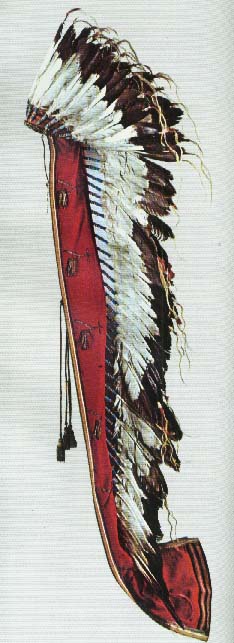 Adjutant R.G. Carter describes Quanah:
Adjutant R.G. Carter describes Quanah:
"...A large and powerfully built chief led the bunch, on a coal-black racing pony. Leaning forward upon his mane, his heels nervously working in the animal's side, with six-shooter poised in air, he seemed the incarnation of savage brutal joy. His face was smeared with black war paint, which gave his features a satanic look. A large, cruel mouth added to his ferocious appearance. A full-length headdress or war bonnet of eagle's feathers, spreading out as he rode, and descending from his forehead, over head and back, to his pony's tail, almost swept the ground. Large brass hoops were in his ears; he was naked to his waist, wearing simply leggings, moccasins and a breechclout. A necklace of bear's claws hung about his neck. His scalp lock was carefully braided in with otter fur, and tied with bright red flannel. His horse's bridle was profusely ornamented with bits of silver, and red flannel was also braided in his mane and tail, but, being black, he was not painted. Bells jingled as he rode at headlong speed, followed by the leading warriors, all eager to outstrip him in the race. It was Quanah, principal war chief of the wild Qua-ha-das."
Marker 1-Site of the MacKenzie Trail
Marker Title: Site of The MacKenzie Trail
City: Snyder
Marker Location: 26th and Avenue R, southeast corner of courthouse square,
Snyder.
Marker Text: Following the Civil War, the Texas frontier pushed westward,
giving rise to renewed hostilities as the white man once again invaded
Indian lands. Foremost in the campaign to calm the frontier was Col. Ranald
S. MacKenzie, who blazed trails from Ft. Griffin to the Plains and from
Ft. Concho to Palo Duro Canyon in the Panhandle. Tons of supplies for
MacKenzie's forces--varying from 600 to 800 men--were freighted from Ft.
Griffin to his main camp on the Brazos River fresh water fork (now White
River), there dispersed to his troops. A second major trail was charted
when his entire force moved from Ft. Concho to the Fresh Water Camp, passing
a major campsite at MacKenzie Mountain (20 mi. N of Snyder). The Fresh
Water Camp was one of the first made in the 1871 campaign in which MacKenzie
was outmaneuvered by Quanah Parker (son of captive Cynthia Ann Parker
and Comanche chief Pete Nocona). In 1874 it was also the last campsite
used after MacKenzie totally defeated massed Cheyenne, Kiowa, and Quahadi
Comanche forces in Palo Duro Canyon. Abstracts of the original townsite
of Snyder, made in 1881, twice use "The MacKenzie Trail" as
reference, setting its course across the Snyder Square. (1967) More
Marker 2-Mackenzie Trail
Marker Title: The Mackenzie Trail
City: Stamford vicinity
Year Marker Erected: 1959
Marker Location: from Stamford, take US 277 north about 0.5 mile to junction
with US 283
Marker Text: "Over a million buffalo hides hauled East, route settlers
West" A map of Crosby, Dickens, King, Knox, Baylor, Garza, Kent,
Stonewall, Haskell and Throckmorton Counties, across which runs the Mackenzie
Trail, is shown in the next panel. "Tonkawa Indians guided Mackenzie
to defeat Comanches in Tule Canyon, end Indian power in Texas" "Trail
died from R. R. 1900. Along the trail began Longhorn Ranches." Printed
in the blocks at the base of the marker from left to right, beginning
with the top row: "J.C. Bryant / Mr. and Mrs. S.W. Scott / Captain
W.E. Rayner / J.E. Murfee, Sr. / SMS Ranches / City of Haskell/County
of Haskell / R.V. and Tennie B. Colbert / Dr. L.W. Hollis / Mr. and
Mrs. A.H. Tandy / FW & D Ry Company / Erected by Mack-Trail Memorial
Associaiton, Bernard Buie" Bottom Row: "W.L. Harrison / S.
Burk Burnett / Thomas Lloyd Burnett / Clifford B. Jones / Mr. and Mrs.
B.C. Humphrey / R.L. Penick / County of Jones / M.S. Pierson / Sculptor
W.M. Chase, 1959 More
Marker 3-Site of MacKenzie Cavalry Camp
Marker Title: Site of MacKenzie Cavalry Camp
Address: SH 211, west city limits in roadside park
City: Wilson
Year Marker Erected: 1967
Marker Location: SH 211, west limit of Wilson in Roadside Park
Marker Text: At or near this spot, Colonel Ronald S. Mackenzie, with two
companies of United States 4th Cavalry, was overtaken on Dec. 4, 1874,
by a snowstorm. Forced to spend the night here without wood or water,
or grass for the horses, troops called this the most miserable night of
their duty in the Southwest. Several horses froze to death. MacKenzie
was hunting here for straggling Indians, during last weeks of 1874 campaign
to confine tribes to reservations. On Dec. 5 his troops reached Tahoka
Lake, where they found shelter under a cliff. (1967)
The following is from the book, On the Border with Mackenzie, by R.G. Carter:
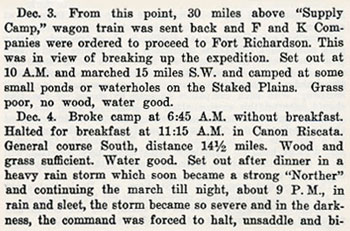
Marker 4-MacKenzie Scout Trail
Marker Title: Mackenzie Scout Trail
Address: Broadway & Ave. H
City: Lubbock
Year Marker Erected: 1936
Marker Location: (Courthouse Grounds adjacent), intersection of H and
Broadway, Lubbock. Private Marker.
Marker Text: This marks one route of the Mackenzie Scout Trail extending
from Camp Supply, Crosby County to Fort Sumner, New Mexico and used by
the Army, 1872-1875, by buffalo hunters, 1876-1878, and by cattlemen 1878
until the fencing of the range. Erected by Nancy Anderson Chapter, N.S.D.A.R.
1936. This block of granite is from the wall that encloses the grave of
Nancy Anderson, 1750-1827, near Chester, S.C.
Marker 5-Main Supply Camp on Historical MacKenzie Trail
Marker Title: Main Supply Camp on Historic MacKenzie Trail
Address: 4 mi. E on US 82
City: Crosbyton
Year Marker Erected: 1967
Marker Location: From Crosbyton, take US 82 about 4 miles
Marker Text: Trail followed by Gen. Ranald Mackenzie, U.S. 4th Cavalry
in 1871 frontier campaign. He camped at Dewey Lake after brush with Indians.
In 1872, he was again ordered to ferret out the Comanches. From his main
supply camp on Brazos River Freshwater Fork (now White River), he launched
a drive against Quanah Parker. Ended with fights in Palo Duro and Tule
Canyons, last battles between Indians and Cavalry in this area; opened
the Plains to white settlement. 1967
Marker 6- Battle of North Fork of Red River
Marker Title: Battle of North Fork of Red River
City: Lefors
County: Gray
Year Marker Erected: 1972
Marker Location: located on R.O.W. of SH 273 10 miles SE of Lefors.
Marker Text: On Sept. 29, 1872, Col. Ranald S. MacKenzie (1840-89) found
in this area a 262-tepee village of Comanches defying treaties that sought
to confine them on Indian Territory reservations. MacKenzie's 231 U.S.
Cavalry and Infantrymen captured the village in half an hour and routed
Chief Mow-Way's warriors, who made a desperate resistance from sheltering
creek banks. That night the Indians succeeded in recapturing their horses
from an army guard detail. This taught MacKenzie a lesson that led to
his eventual victory in the 1874 campaign to subdue the Indians. More
Marker 7-One of the Trails of Ranald S. MacKenzie
Marker Title: One of the Trails of Ranald S. MacKenzie
Address: FM 1072, 0.5 mi. South
City: Fieldton
Year Marker Erected: 1977
Marker Location: from Fieldton, take FM 1072 south, about .5
Marker Text: Colonel Ranald S. MacKenzie (1840-89) of the United States
Army was ordered in the 1870s to conquer Indians of Texas frontiers. He
led 240 enlisted men and eight officers in an expedition along the draw
here. Heading toward New Mexico, he hoped to break up a ring of traders
paying Indians to steal cattle and horses. He marched past this point
about August 1, 1872, in a swift, secret move against the traders. The
path beaten out by his men was serviceable later to scouts and settlers.
Its traces are still known as MacKenzie's Trail. (1977) More
Marker 8-The Old MacKenzie Trail
Marker Title: The Old MacKenzie Trail
Address: Columbia & US 70, at Courthouse
City: Plainview
Year Marker Erected: 1936
Marker Location: Courthouse Grounds, Columbia Street and US 70, Plainview
Marker Text: General Ranald Slidell MacKenzie The Old MacKenzie Trail
by "Larry" Chittendon Stretching onward toward the sunset, o'er
prairie, hill and vale, far beyond the double mountains winds the Old
MacKenzie Trail. Ah, what thoughts and border memories does that dreaming
trail suggest, thoughts of travelers gone forever to the twilight realms
of rest. Where are now the scouts and soldiers, and those wagon trains
of care, those grim men and haggard women and the echoes whisper - where?
Ah, what tales of joy and sorrows could that silent trail relate: tales
of loss, and wrecked ambitions, tales of hope, of love, and hate: Tales
of hunger, thirst, and anguish tales of skulking Indian braves, tales
of fear, and death, and danger, tales of lonely prairie graves. Where
are now that trail's processions, winding westward sure and slow? Lost:
ah, yes, destroyed progress, gone to realms of long ago. Nevermore shall
bold MacKenzie, with his brave and dauntless band, guide the restless,
roving settlers through the Texas borderland. Yes, that soldier's work
is over, and the dim trail rests at last, but his name and trail still
lead us through the borders of the past. The MacKenzie Trail first crossed
by General Ranald Slidell MacKenzie, 4th United States Cavalry, in 1871
in quest of warring bands of Indians. Erected by the state of Texas with
funds appropriated by Federal government to commemorate one hundred years
of Texas independence. 1836 - 1936
Marker 9-Archeological Sites at MacKenzie Reservoir and Tule Canyon
Marker Title: Archeological Sites at MacKenzie Reservoir and Tule Canyon
Year Marker Erected: 1979
Marker Location: From Silverton, take SH 206 about 11 miles to roadside
park; marker is located at overlook at entrance to recreation
Marker Text: Before this area was covered by MacKenzie Reservoir, evidence
of human occupancy was found at 77 recorded archeological sites. The earliest
artifacts date back 10,000 years to a bison kill. Prehistoric occupancy
is indicated by burial sites, shallow hearths, and stone tools. Gun flints,
glass beads, and metal objects confirm 18th century European contact.
By 1874 Colonel Ranald S. MacKenzie's 4th Cavalry had driven the Indians
from the Tule Canyon area which had been a lush grazing ground for buffalo
and antelope. (1979) Incise in base: Marker Sponsor: Briscoe County Historical
Commission - 1979
Marker 10-Palo Duro Canyon
Marker Title: Palo Duro Canyon
Address: 17 mi. E on SH 86
City: Tulia
County: Swisher
Year Marker Erected: 1936
Marker Location: from Tulia, take SH 86 east about 17 miles to marker
site near county line on south side of highway.
Marker Text: Two miles north of here General Ranald S. MacKenzie, 41st
U.S. Cavalry, ordered shot the 1450 horses captured from Indians in battle
in Palo Duro Canyon, September 28, 1874, to prevent their possible recovery
by the Indians to return to their reservations on foot. More
Marker 11-MacKenzie Trail
Marker Title: MacKenzie Trail
City: Hereford
Year Marker Erected: 1965
Marker Location: missing
Marker Text: Along this lonely, arid trail Gen. Ranald S. MacKenzie led
his troops on scouting forays in the 1870s. Known for bravery and skill
as a Civil War officer, he was sent to Texas and quickly adjusted to dangers
and problems of frontier fighting. He fought against Comanches at Blanco
and Tule Canyons. On Sept. 28, 1874, in Palo Duro Canyon, he led his men
in one of the last major Indian battles in Texas where he slew more than
1,000 horses to cripple Indian action; thus he helped bring peace to the
Texas Panhandle, making it safe for settlers. (1965)
Marker 12-Battle of Palo Duro Canyon, September 28, 1874
Marker Title: The Battle of Palo Duro Canyon, September 28, 1874.
Address: SH 217 at Palo Duro Canyon State Park
City: Canyon
County: Randall
Year Marker Erected: 1967
Marker Location: from Canyon, travel on SH 217 east to entrance of Palo
Duro Canyon State Park, continue through gate on Park Road 5, marker is
at the end of the road, about 5 miles
Marker Text: One of the most significant Battles of 1874-75 Indian campaign;
columns of troops converging from five directions harassed Indians on
the Panhandle Plains for over six months. The 4th Cavalry under Colonel
Ranald S. MacKenzie, moving north from Fort Concho, tracked a large band
of Indians to their secret canyon camp. Moving silently at dawn down a
perilous path on the south rim, the first troops reached the floor of
the canyon before the aroused camp fled. Some of the warriors took up
positions on the canyon walls from which they fired on the troops, seeking
to give their families time to escape. Realizing his tactical disadvantage,
MacKenzie ordered the Indian camp and supplies burned and withdrew, taking
along 1,400 captured horses (1,000 of which he later destroyed). The cavalry
suffered no causalities in the fight and only four Indian dead were counted.
Having lost half their horses as well as all their supplies and shelter,
the Indians drifted back to their reservations at Fort Sill and Fort Reno.
(1967) More on Palo Duro Canyon Battle
Marker 13-Old Mobeetie Trail
Marker Title: Old Mobeetie Trail
City: Clarendon
County: Donley
Marker Location: NOT LOCATED - S.H. 70, north of Clarendon
Marker Text: (to early town, about 40 mi. NE) A road older than recorded
history; carved out in centuries of wintertime travel to the south, spring
migration to the north, by millions of bison and by Indians who lived
by hunting these large animals. Important in era of Texas Panhandle settlement.
Used in 1873-1874, when first lifelong residents put dugout dwellings
in the Panhandle and began to hunt buffalo to fill demand for hides and
meat. Fort Elliott (more),
established 1875 to regulate Indians resisting white settlement, soon
had as a neighbor the town of Mobeetie, which for some years was the county
seat for 28 counties and a place to go for medical aid, supplies, and
access to stage travel. In 1876 Kansans came this way south for better
hunting, calling this "Rath Trail," for their leader. Also,
in 1876 cattlemen began to bring herds here. By 1880 this ancient path
was a southern arm of Jones and Plummer Trail, over which cowboys moved
longhorns to railroads and northern cattle markets. Beginning about 1887
the Mobeetie Trail was used by "nesters" taking up farm lands
alongside the old great ranches. Those it served founded and expanded
agricultural-commercial economy of the Panhandle.
Marker 14-Mobeetie
Marker Title: Mobeetie
Address: SH 152 & FM 48
City: Mobeetie
County: Wheeler
Year Marker Erected: 1967
Marker Location: At intersection of S.H. 152 & F. M. 48, north side
of road-Mobeetie
Marker Text: Oldest town in Texas Panhandle. Originally, a trading post,
2 miles south, 1874; moved nearer to Fort Elliott, 1875. Earlier called
Sweetwater, was renamed in 1879. Courthouse was completed by Mark Huselby,
first county tax assessor, and other citizens. Popular with hunters, cowboys,
gamblers - town in1881 became judicial center or 35th District. Temple
Houston, son of the hero Sam Houston, was district attorney and the first
state senator for this district. After bypass by the Santa Fe Railroad
(1888) and a destructive 1898 tornado, Mobeetie declined. (1967)
Mobeetie Jail Museum
Museum Name: Mobeetie Jail Museum
Mailing Address: Route 1 Box 290
City: Mobeetie
Zip Code: 79061
Street Address: Court House Square
Area Code: 806
Phone: 845-2028
County: Wheeler
Marker 15-Rescue of Two White Girls by Lt. Frank Baldwin
Marker Title: Rescue of Two White Girls by Lt. Frank Baldwin
City: Pampa
County: Gray
Year Marker Erected: 1936
Marker Location: take SH 273 south from Pampa. Marker is located at SH
273 and Spur 398 in a small park just north of Lefors.
Marker Text: Ten miles southwest of here Lieutenant Frank D. Baldwin commanding
two companies of United States troops attacked a large band of Cheyenne
Indians and rescued two white girl captives, November 8, 1874. More
on Lt. Baldwin
Marker 16-Battle of Adobe Walls
Marker Title: Battle of Adobe Walls
City: Borger
County: Hutchinson
Year Marker Erected: 1936
Marker Location: at picnic area 6 miles north of Borger
Marker Text: Fifteen miles to the site of the Battle of Adobe Walls fought
on November 25, 1864 between Kiowa and Comanche Indians and United States
troops commanded by Colonel Christopher Carson, 1809-1868. This was "Kit"
Carson's last fight. (1936)
Marker 17-First Battle of Adobe Walls
Marker Title: First Battle of Adobe Walls
City: Stinnett
County: Hutchinson
Year Marker Erected: 1964
Marker Location: from Stinnett take SH 207, north to junction with SH
136
Marker Text: Largest Indian battle in Civil War. 15 miles east, at ruins
of Bent's Old Fort, on the Canadian. 3,000 Comanches and Kiowas, allies
of the South, met 372 Federals under Colonel Kit Carson, famous scout
and mountain man. Though Carson made a brilliant defense - called greatest
fight of his career - the Indian won. Some of the same Indians lost in
1874 Battle of Adobe Walls, though they outnumbered 700 to 29 the buffalo
hunters whose victory helped open the Panhandle to settlement. (1964)
More on Adobe Walls
Marker 18-Battle of Adobe Walls
Marker Title: Battle of Adobe Walls
City: Stinnett
County: Hutchinson
Year Marker Erected: 1936
Marker Location: from Stinnet take SH 207, north about 11.2 miles, turn
east onto county road and continue about 17 miles (road will make several
sharp turns) to battle site, several monuments on site.
Marker Text: Was fought here November 25, 1864, when Colonel Christopher
(Kit) Carson (1809-1868) with a few companies of United States troops
under the protection of the Adobe Walls attacked a band of hostile Kiowa
and Comanche Indians and killed over 60 braves. This was "Kit"
Carson's last fight. (1936)
Marker 18-1/2-Site of Old Zulu Stockade
Marker Title: Site of Old Zulu Stockade
City: Morse vicinity
County: Hansford
Year Marker Erected: 1968
Marker Location: 4 mi. N of Morse on SH 136, then 1 mi. W on FM 520
Marker Text: In 1875, a large, two-room pole building furnished with staple
groceries and ammunition became the first trading post in Texas above
the Canadian River. The stockade, located in Indian-infested country,
was fittingly named for the fierce Zulu tribe of Africa. It began as a
buffalo camp which crack hunters Jim and Bob Cator (from England) had
made the first permanent Panhandle residence at Christmas, 1873. In 1876
Zulu became a major depot on the Ft. Dodge-Ft. Bascom military road, and
it eventually received a post office contract. It was finally abandoned,
1912. (1968)
Marker 19-Site of Lyman's Wagon Train Battle
Marker Title: Site of Lyman's Wagon Train Battle
Address: 7 miles S on US 60/83; 10 mi. E on SH 33
City: Canadian
County: Hemphill
Year Marker Erected: 1967
Marker Location: from Canadian, travel south on US 60/83 approximately
7 miles, turn east on SH 33 and go about 10 miles - marker is on south
side of road.
Marker Text: During the U.S. Army campaigns in 1874 against marauding
Indians, Captain Wyllys Lyman led a wagon train to Camp Supply, Oklahoma,
for rations for General Nelson A. Miles' troops on duty in Texas. On the
way, Indians attacked, and the longest Indian battle in Panhandle history
ensued. Fighting from a wagon corral September 9 to 14, Lyman and 95 soldiers
held off about 400 Comanche and Kiowa Indians. A scout escaped and reached
Camp Supply for help. Company K, 6th Cavalry, traveled 80 miles without
rest in a raging rainstorm to aid the wagon train. On its arrival, the
Indians fled. (1967) More on Lyman's Wagon Train
Battle
Marker 20-Buffalo Wallow Battle Ground
Marker Title: Buffalo Wallow Battle Ground
City: Canadian
County: Hemphill
Year Marker Erected: 1925
Marker Location: from Canadian, travel south on U.S. 83, approximately
15.5 miles, turn left onto S.H. 277, continue approximately 7 miles to
dirt road, take right turn, continue about 1 mile to marker.
Marker Text: Here on September 12th, 1874, two scouts and four soldiers
defeated 125 Kiowa and Comanche Indians. Scouts: William Dixon, Amos Chapman
Soldiers: Sergeant Z. T. Woodall, Co. I; Peter Rath, Co. A; John Harrington,
Co. H.; George W. Smith, Co. M, 6th Cavalry. Stand Silent: Heroes here
have been who cleared the way for other men. Erected by Panhandle-Plains
Historical Society, September 12th, 1925. This site marked under direction
of J.J. Long, Mobeetie, Texas. Mrs. William Dixon, Miami, Texas. (1966)
Story
Marker 21-Pease River Battlefield
Marker Title: Pease River Battlefield
City: Crowell
County: Foard
Year Marker Erected: 1968
Marker Location: In city park, Highway 6-Crowell (site located 8 miles
northeast)
Marker Text: In 1860, at the Battle of Pease River, Indian captive Cynthia
Ann Parker and her daughter, Prairie Flower, were rescued by Texas Rangers
under Captain L.S. Ross (later Governor of Texas). Cynthia Ann, most
celebrated of all Comanche captives, had been taken at age 9 in a raid
on Fort Parker, May 19, 1836. Traders who saw her later said she had taken
the name "Naduah" and wished to remain among her adopted people.
She married Chief Peta Nocona, by whom she had 2 sons, Pecos and Quanah
Parker. Although she was returned to her uncle's family, she was never
completely happy and tried to escape several times. She died 1864. (1968)
More On Pease River Battle
Marker 22-First Battle of the Palo Duro Canyon
Marker Title: First Battle of the Palo Duro Canyon
City: Wayside
County: Armstrong
Year Marker Erected: 1971
Marker Location: from Wayside, take SH 207 8 miles north to roadside park.
Marker Text: (Aug. 30, 1874) Opening fight in 1874-75 U.S. action against
tribes supposedly on Indian Territory reservations (present Oklahoma),
but actually occupying the Texas Panhandle. South from Fort Dodge, Kans.,
marched 750 soldiers under Gen. Nelson A. Miles, who on Aug. 28 had to
leave guards with his stalled supply train. Attacked on Aug. 30 in rugged
terrain by superior numbers of Cheyennes, Comanches, and Kiowas, Miles
won victory in 5-hour fight at Battle Creek (10 mi. E of here) -- first
of 14 fights in Red River War that broke the Indians' power in Texas Panhandle.
(1971)
Marker 23-McClellan Creek
Marker Title: McClellan Creek
City: Pampa
County: Gray
Battle Location: South of the present town of Pampa in Gray County.
Text: From the book, Battlefields of Texas, by Bill Groneman: Lieutenant
H. J. Farnsworth led a patrol out of the camp of Major William R. Price
on the Washita River, moving south toward McClellan Creek in early November
1874. On November 6, at McClellan Creek, his patrol was attacked by about
one hundred Cheyenne warriors under Grey Beard. The troopers were pinned
down, and the fight lasted from 1:30 p.m.until nightfall. Farnsworth's
men escaped under the cover of darkness and were pressed so hard by the
Cheyennes that they were forced to leave their dead on the field to be
mutilated by their foe.
Marker 24-Yellow House Canyon
Marker Title: Yellow House Canyon
City: Lubbock Texas
County: Lubbock
Text: From the book, Battlefields of Texas, by Bill Groneman: Quahadi
Comanches under Black Horse had obtained a permit to leave their reservation
and hunt in Texas in December of 1876. Black Horse used the opportunity
to hunt buffalo hunters and take revenge on them for the destruction of
the buffalo herds.
In March of 1877 a group of buffalo hunters in Rath City, fired up on whiskey and talk of revenge, formed themselves into a company under "Captain" Jim White and rode out to find the Comanches. White turned back after he became ill,and the command fell to "Lieutenant" Jim Smith. Only about half of the hunters were mounted; the rest rode in wagons where the hunters carried an abundant supply of whiskey to fuel their expedition.
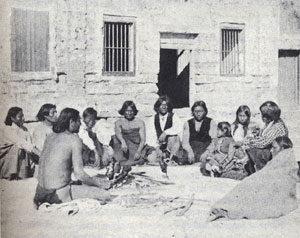 |
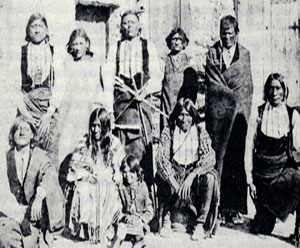 |
Black Horse and others Languish in a Florida Prison (1st pic, far right, 2nd pic, 2nd from right)
|
|
After two weeks the hunters found Black Horse's camp in "Hidden Canyon." The mounted hunters divided and moved along the plains on either side of the canyon, while the dismounted men advanced down the center of the canyon.
The Comanches were caught by surprise when Smith ordered the attack but quickly rallied. Even the Comanche women took part in the fight, aggressively charging the hunters with pistols while their men found defensive positions. The fight continued until mid afternoon The hunters were finally forced to retreat after the Comanches set a grass fire and began to close in on them under the cover of the smoke. The hunters made it back to their wagons and set their own fires to cover their retreat back to Rath City.
O1-Battle of the Washita
O2-Antelope Hills
Home | Table of Contents | Forts | Road Trip Maps | Blood Trail Maps | Links | PX and Library | Contact Us | Mail Bag | Search | Intro | Upcoming Events | Reader's Road Trips Fort Tours Systems - Founded by Rick Steed |

